Excerpts from Jim Conrad's
Naturalist Newsletter
from the September 8, 2013 Newsletter issued from the Frio Canyon Nature Education Center in the valley of the Dry Frio River in northern Uvalde County, southwestern Texas, on the southern border of the Edwards Plateau; elevation ~1750m (~5750 ft); N29.62°, W99.86°; USA
SKULLCAP
On the Dry Frio's bare sand and cobblestone banks, six-inch-tall (15cm) green sprouts issued from a much-pruned, woody, bushy base apparently chewed on by deer or maybe shattered during the last flashflood. One sprout bore two purple, dog-face-type flowers, shown below:
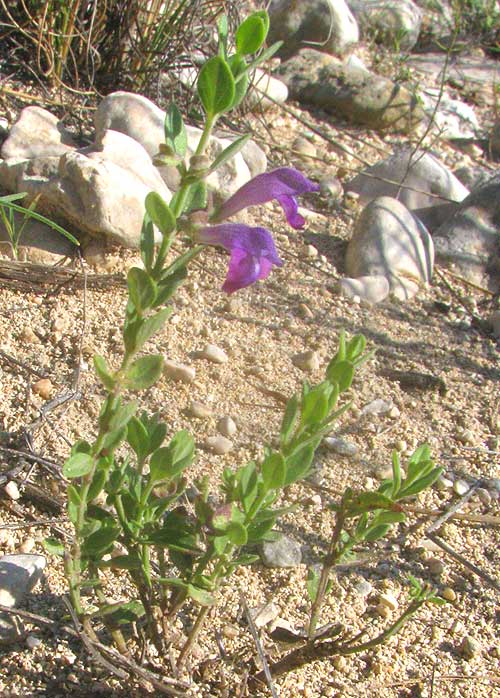
That's the flowers close-up below:
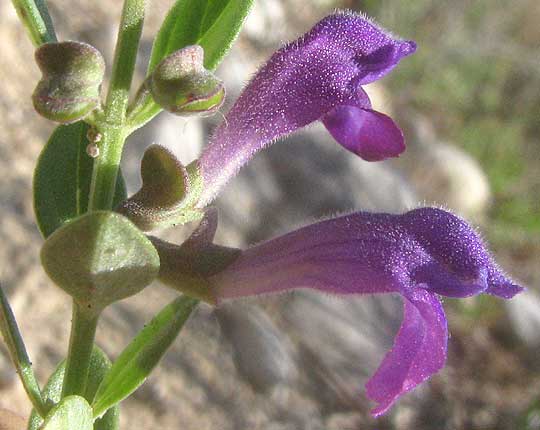
Seeing the flowers' pronounced bilateral symmetry and the stems' opposite leaves (two per stem node), and the stem itself square in cross-section, most wildflower lovers recognize this as a member of the Mint Family, the Lamiaceae. When we see the remarkable disk-shaped protuberance atop each calyx, not only are we immediately confirmed that we have a mint, but also we know which Mint Family genus we have. It's the large, important genus Scutellaria, whose species generally are known as skullcaps. Experts estimate that maybe 300-425 skullcap species exist worldwide.
In our area we can expect two skullcap species. The calyx of the most commonly occurring one, Scutellaria drummondii, is long-hairy and the plant itself is an annual herb. You can see that the calyx of our plant lacks long hairs and that the green shoots arise from a definitely woody base. Therefore, this is our less common second species.
In books it's listed variously as Wright's Skullcap, Bushy Skullcap and Shrubby Skullcap. It's SCUTELLARIA WRIGHTII, in the whole world occurring naturally only in Texas and Oklahoma.
On a Gardenweb.Com forum I find Registered Herbalist Nicole Telkes of central Texas regarding Wright's Skullcap as a "calming" herb. Further she writes that "The wrightii species is more bitter so I use it for pain and headaches as well as calming the digestive tract."
from the August 24, 2014 Newsletter issued from the Frio Canyon Nature Education Center in the valley of the Dry Frio River in northern Uvalde County, southwestern Texas, on the southern border of the Edwards Plateau; elevation ~1750m (~5750 ft); N29.62°, W99.86°; USA
A SKULLCAP'S HYDROBALLOCHORY
On the dry slope of a shallow roadcut through limestone a certain small wildflower caught my attention not with its flowers but with its dried-out calyxes, which glowed warmly tan-colored in the morning light. Below, you can see its admittedly somewhat thirsty and scrappy looking clump of stems:
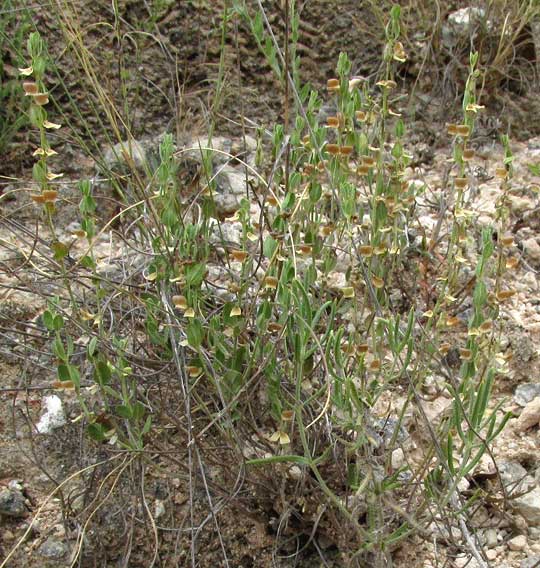
Up close, the desiccated calyxes displayed a form as unusual and distinctive for this particular group of plants, as cyathia are for the euphorbias. You can see what I mean below:
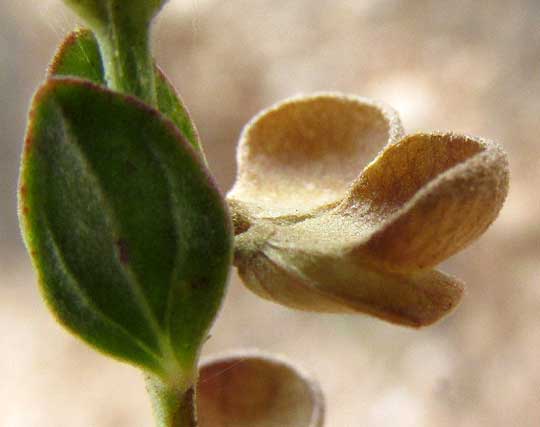
When you have a plant with opposite leaves like these (two leaves per stem node), and calyxes with such pronounced "hoods," you need to think of the Mint Family's genus Scutellaria. Scutellaria species often are referred to as skullcaps, the name reflecting the presence of the hoods atop the calyxes. Hoods in some species are just low ridges or other shapes, but I don't recall having ever seen a Scutellaria hood so definitely shaped like the head of a Lacrosse stick.
I recognized this plant as the handsomely purple-flowered Wright's Skullcap, Scutellaria wrightii, we found on the Dry Frio's dried-out river bed last September. {See above} However, only now do I notice that something must be going on with these extraordinary calyxes. Therefore, now I've done some Googling to see if anything has been published about the calyxes of the Wright's skullcap. And, it has!
In the November 1, 2010 issue of The Texas Journal of Science, Allan Nelson and Jim Goetze published a paper on how the calyxes of two skullcap species, one of which is our Wright's Skullcap, facilitate the dispersal of the plant's nutlet-type fruits during rain, in a process known as "hydroballochory." Their paper is freely downloadable at TheFreeLibrary.Com.
In that paper they write, "When a drop of rain hits the cup-shaped top of a yellow or brown scutellum, it dehisces and falls off the plant and the resulting mechanical energy from this event causes the scales to throw the nutlets away from the plant." The hood is what he's calling a scutellum. "Dehisces" means "splits open." Most of the calyxes on our plant already had lost their tops, leaving only the lower halves, with the nutlets already thrown away from the plant. Below you can see a couple of empty lower halves:
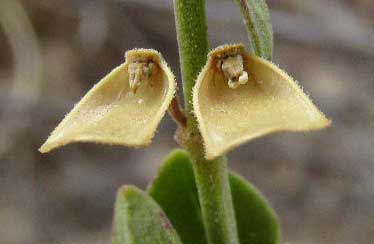
So, a raindrop hits the cup, causing both the calyx's hood-bearing top to be knocked off, and the lower part of the calyx, which holds the nutlet-type fruits, to bend down beneath the raindrop's weight. When the lower part of the calyx rebounds after being knocked downward, it tosses the nutlets lying on its scoop-like lip away from the plant, dispersing them away from the parent plant.
How about that? Anytime something strikes you as a little unusual, it's worth Googling the matter to see if something special is going on.